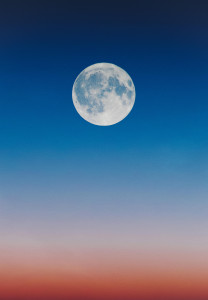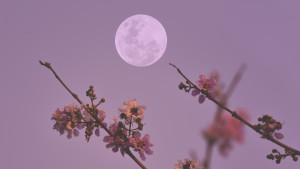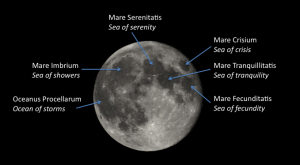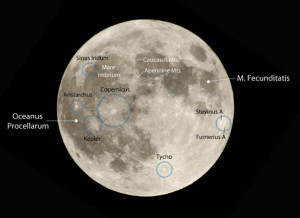The night sky ignites with a captivating glow as the Pink Moon graces us with its presence. As a natural satellite of Earth and a faithful companion for millions of years, the Moon has fascinated humanity for centuries. Its serene glow and enigmatic features have sparked curiosity among humans for centuries. Across languages and cultures, intricate names like ‘Selene’ in Greek, ‘Mond’ in German, ‘Lune’ in French, ‘Luna’ in Spanish, and ‘Al-Qamar’ in Arabic, reflect the profound connection we share with our lunar neighbor.
The Moon was formed 4.5 billion years ago when a Mars-sized object named “Theia” collided with Earth. From there, the moon has undergone many changes in its surface features. There are many lunar landforms, such as impact craters, lunar valleys, and maria, that are noteworthy to watch. This “Pink Moon,” watch some fascinating features of the lunar surface with your binoculars or a small telescope.
What is the Pink Moon?

The Pink Moon, also known as the Sprouting Grass Moon, Egg Moon, Fish Moon, Bak Poya, and the Pesach Moon or Passover Moon, traditionally signifies the arrival of spring. It graces the skies during the first full moon of April, ushering in a season of renewal and growth. While the moon itself won’t take the pinkish hue, the name originates from the blossoming of pink wildflowers, such as Moss Phlox (Phlox Subulata), in North America during this time.
Mark Your Calendar
The Pink Moon in 2024 falls on Tuesday, April 23rd, rising at 7 PM IST (Local Time). Mark your calendar for a night of lunar wonder! This full moon, bathed in the ethereal glow of spring, ignites the imaginations of all the selenophiles across the world and casual observers alike.
Significance of the Pink Moon

The Pink Moon also holds cultural significance across various parts of the world, connecting different traditions under the same sky.
- The pink moon, also known as the Pesach moon or Passover moon, commemorates the Jewish exodus from Egypt, and families gather for special Seder meals during the first two nights.
- In Hinduism, this full moon coincides with Hanuman Jayanti, a vibrant festival celebrating the birth of Lord Hanuman, the powerful monkey god known for his devotion and strength.
- For Buddhists, particularly in Sri Lanka, it’s Bak Poya, a time to remember the Buddha’s visit to the island to settle a dispute between chiefs, preventing war.
The pink moon is also culturally significant in other traditions. In Islamic tradition, it falls near the middle of Shawwal, the tenth month in Islam, and Chinese culture, it is the third month of the Chinese Year of the Dragon.
Observing the Pink Moon
While the moon won’t appear pink, it’s still beautiful. Here are some pro tips to observe the Pink Moon:
- Finding a good location: Find a place with a panoramic view of the entire sky. The best viewing times are during twilight when the Moon is relatively low on the horizon.
- Naked eye vs. Binoculars/Telescope: The naked eye is an excellent tool for observing the Moon. However, binoculars or a telescope can significantly enhance your experience. Even a small telescope can reveal the craters, maria, and mountain ranges in greater detail.
- Lunar Observation Maps: Equip yourself with lunar maps to navigate the Moon’s surface. These maps can help you identify prominent features on the lunar surface. You can check the NASA website for real-time information on the moon’s dramatic features.
Discovering Lunar Landmarks
The Moon is like a giant, dusty storybook! Instead of words and pictures, it has craters, mountains, and dark plains that tell the story of its wild past. Here are some cool moon sites you can check out with the aid of binoculars or a telescope.

Lunar Maria– Lunar Maria are large, dark, flat plains on the moon’s surface. They primarily comprise solidified basaltic lava from volcanic eruptions on the lunar surface. Maria are the visible dark patches on the moon’s surface named after the Latin word for “seas.” Some maria are circular, hinting at origins from giant asteroid impacts that created the basins, which were later flooded with lava. Other maria are more irregular in shape and have more mysterious origins. On the Full Moon night, you can easily identify Mare Crisium (Sea of Crises), Mare Tranquillitatis (Sea of Tranquility), Mare Serenitatis (Sea of Serenity), Mare Fecunditatis (Sea of Fecundity), Mare Imbrium (Sea of Rains), Oceanus Procellarum (Ocean of Storms).
Impact Craters: Craters are the most common surface feature on the Moon. They are formed by the impact of asteroids and blobs of comets. Craters are found in all sizes, from small craters that are only a few meters wide to large craters that are hundreds of kilometers wide.On Pink Moon Day, catch the biggest impact craters, Tycho, Copernicus, and Clavius. A small telescope or binoculars will give a detailed picture of the crater’s surface features.
Want to know more about impact craters on the moon? Consider reading our previous blog, Craters on the Moon and Their Origin.
Tycho: This gigantic crater is one of the youngest on the moon’s surface, estimated to be around 100 million years old. The crater is located on the southern part of the lunar landform, making it a very recognizable landmark due to its bright central peak and the extending radial fracture lines.

Credit: skyandtelescopes.org
Copernicus: This 93-km-diameter crater is another young crater, around 800 million years old. It has a prominent central peak, terraced inner walls, and a flat floor. You can spot Copernicus in the Oceanus Procellarum, a huge, dark area filled with volcanic rock. It’s like a shiny gem in a sea of black.
Clavius: This monster crater is one of the largest craters visible from Earth, with a diameter of 225 kilometers! Clavius is located in the southern hemisphere of the moon and is easily spotted with the aid of a telescope. It has a central peak, a terraced inner wall, and a flat floor.
Just like the Moon has its craters formed by meteorite impacts, Earth has its own share of impressive scars from cosmic collisions. Curious about these remarkable features? Dive into our list of the Top 5 Magnificent Impact Craters on Earth and uncover the stories behind these geological marvels.
Lunar Mountains and Valleys: The lunar landscape boasts majestic mountain ranges and sprawling valleys. During the Pink Moon, the entire lunar surface is illuminated, obscuring the features of lunar mountains and valleys. But as the moon progresses through its phases, the play of light and shadow will highlight the textures and depths of these landmarks.
These lunar surface features offer a wealth of information about the Moon’s history, geology, and potential for scientific exploration and future human missions. The Moon’s geology is of great interest to scientists, astronomers, and space agencies, as it holds treasure for future human missions to the lunar surface.
Observing the moon under different lunar phases can reveal fascinating details. During the Pink Moon, when the whole moon lights up, it’s a bit harder to see some details because there are no shadows. But don’t worry, whenever you look up and take notes in your Astro-Diary, you’re starting a new chapter in your moon adventure. Happy moon gazing!



